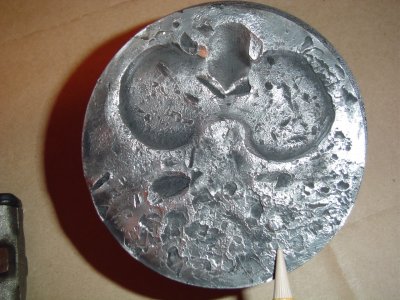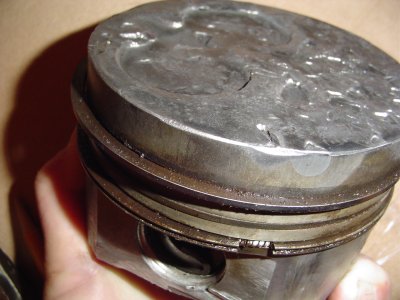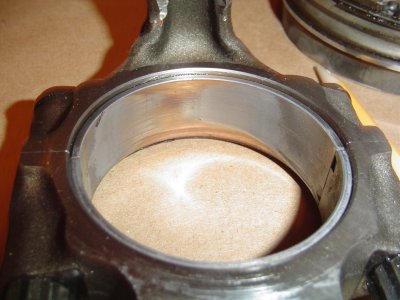You are using an out of date browser. It may not display this or other websites correctly.
You should upgrade or use an alternative browser.
You should upgrade or use an alternative browser.
6.9 Build-up
- Thread starter Ironman03R
- Start date
GenLightening
Yeah, it's a CHEVY!
Glad you mentioned that was a pic of a piston. At first glance I thought it was a pic of the moon! 
Any others in that motor with that amount of damage? Says a lot for how strong they are.

Any others in that motor with that amount of damage? Says a lot for how strong they are.
Higher piston/bearing speed is bad when you add boost. It also shortens the time the piston stays parked at TDC...
I've never rebuilt an engine, nor dabled in engine design, so the following is nothing other than an attempt to learn.
Explain to me how having a shorter connecting rod changes the piston dwell time OR piston or bearing speed. My guts tell me both of those are controlled by the crank. I would think the piston speed would remain the same, as would the dwell time.
icanfixall
Official GMM hand model
I believe its the closer to the center of rotation the less "time" at a stop. With the long stroke motors of years ago the piston could stop at the top or bottom of a stroke for a longer time but.. This longer stroke had side affects too. The piston would wobble more at the top and the oil rings wern't as effective because they lost contact with the cylinder walls. Som high reving motors in the Indy cars have a 2 1/2 inch bore and a 1 1/2 inch stroke. Talk about piston speed in feet per minute and its really amazing. I think the motor I was looking at had a piston that did 200 rpm per second at peak rpm of the motor. No, I don't remember what the rpm was but something like 12,000 rpm is what I kinda remember....
Diesile
Full Access Member
About that .054 gasket that Gasket Works would do....aren't our Felpro's already .070+/-. The crushed ones out of my 6.9 were close to that.
Seems like a .090 or .100 gasket might be needed?
Seems like a .090 or .100 gasket might be needed?
zukinut
Full Access Member
Why do you mill the tops of the pistons, is it to get compression down, or ?
Trying to learn.
Thanks in advance.
Will
Trying to learn.
Thanks in advance.
Will
Metalmacguyver
Full Access Member
Why do you mill the tops of the pistons, is it to get compression down, or ?
Trying to learn.
Thanks in advance.
Will
Exactly.
icanfixall
Official GMM hand model
Milling the piston tops is a two fold thing. All, and I really mean all 6.9 and 7.3 idi motors have the pistons coming up out of the cylinders as much as 31 thousands. Thats just how they are designed. Now knowing that think about the flat cylinder heads... What keeps the pistons from hitting the heads.... Gnomes...  Not really but its the thickness of the head gaskets. I know Felpro gaskets are around 74 thousands thick before being compressed. After that they are around 71 or 72 thousands. They a mls gaskets so they don't compress much. So knowing this you see why its so important to know how much your pistons stick up out of the cylinders. My first rebuild they were between 47 & 54 thoudands. Way too much. When that motor burned down every piston showed a mark from the valves. It was seen but I couldn't measure it. I tried and found it almost a painted look from the vavles. No damage was done... Yet. When you mill the block like I did the distance from the crank center line decreases and the pistons are higher up in the cylinders by that amount. My block lost about 8 thousands because the shop messed up big time. So my new set of pistons are the low comp (the pin is machined 10 thousands higher in the piston) and still I needed to take off around 12 thousands to make them fit where I was comfortable at 24 to 26 thousands above the block surface. Even then my compression is 530 lbs with about 8 thousand miles on the motor. So things will get better. I talked to an engineer at Mahle about milling the piston tops. The recommend no more than around 15 thousands because then the top ring is that much closer to the heat and flame front. Sure, you can mill plenty off because the tops are around .580 thick. Thats almost 5/8 inch. These are the informations I have found. What some do outside of this is at best experimental but thats how we find out what works and what does not.... After I milled my pistons I had a ceramic coating applied to the tops called CBX from Tech Line. They know their stuff about coatings and offer plenty of options and help.
Not really but its the thickness of the head gaskets. I know Felpro gaskets are around 74 thousands thick before being compressed. After that they are around 71 or 72 thousands. They a mls gaskets so they don't compress much. So knowing this you see why its so important to know how much your pistons stick up out of the cylinders. My first rebuild they were between 47 & 54 thoudands. Way too much. When that motor burned down every piston showed a mark from the valves. It was seen but I couldn't measure it. I tried and found it almost a painted look from the vavles. No damage was done... Yet. When you mill the block like I did the distance from the crank center line decreases and the pistons are higher up in the cylinders by that amount. My block lost about 8 thousands because the shop messed up big time. So my new set of pistons are the low comp (the pin is machined 10 thousands higher in the piston) and still I needed to take off around 12 thousands to make them fit where I was comfortable at 24 to 26 thousands above the block surface. Even then my compression is 530 lbs with about 8 thousand miles on the motor. So things will get better. I talked to an engineer at Mahle about milling the piston tops. The recommend no more than around 15 thousands because then the top ring is that much closer to the heat and flame front. Sure, you can mill plenty off because the tops are around .580 thick. Thats almost 5/8 inch. These are the informations I have found. What some do outside of this is at best experimental but thats how we find out what works and what does not.... After I milled my pistons I had a ceramic coating applied to the tops called CBX from Tech Line. They know their stuff about coatings and offer plenty of options and help.
memphisrain
Full Access Member
Milling the piston tops is a two fold thing. All, and I really mean all 6.9 and 7.3 idi motors have the pistons coming up out of the cylinders as much as 31 thousands. Thats just how they are designed. Now knowing that think about the flat cylinder heads... What keeps the pistons from hitting the heads.... Gnomes...Not really but its the thickness of the head gaskets. I know Felpro gaskets are around 74 thousands thick before being compressed. After that they are around 71 or 72 thousands. They a mls gaskets so they don't compress much. So knowing this you see why its so important to know how much your pistons stick up out of the cylinders. My first rebuild they were between 47 & 54 thoudands. Way too much. When that motor burned down every piston showed a mark from the valves. It was seen but I couldn't measure it. I tried and found it almost a painted look from the vavles. No damage was done... Yet. When you mill the block like I did the distance from the crank center line decreases and the pistons are higher up in the cylinders by that amount. My block lost about 8 thousands because the shop messed up big time. So my new set of pistons are the low comp (the pin is machined 10 thousands higher in the piston) and still I needed to take off around 12 thousands to make them fit where I was comfortable at 24 to 26 thousands above the block surface. Even then my compression is 530 lbs with about 8 thousand miles on the motor. So things will get better. I talked to an engineer at Mahle about milling the piston tops. The recommend no more than around 15 thousands because then the top ring is that much closer to the heat and flame front. Sure, you can mill plenty off because the tops are around .580 thick. Thats almost 5/8 inch. These are the informations I have found. What some do outside of this is at best experimental but thats how we find out what works and what does not.... After I milled my pistons I had a ceramic coating applied to the tops called CBX from Tech Line. They know their stuff about coatings and offer plenty of options and help.
An old hotrod trick to avoid that is to use play-doh on the piston tops. Place a fattened out lump of play-doh on the piston top, and then place a cheap set of head gaskets on and torque down the head like you would normally. Then, rotate the engine over a few times, pull it apart, and measure the thickness of the play-doh to get a good idea of how much valve/piston clearance you have. It sucks to have to buy another set of head gaskets, but its cheaper then rebuilding the whole thing again.
For you visual learning types
mR
seawalkersee
It needs a turbo...
I've never rebuilt an engine, nor dabled in engine design, so the following is nothing other than an attempt to learn.
Explain to me how having a shorter connecting rod changes the piston dwell time OR piston or bearing speed. My guts tell me both of those are controlled by the crank. I would think the piston speed would remain the same, as would the dwell time.
Im not the best at describing thigs without a visual aid but I will try. The piston can only travel so far to the top of the bore. Now, with a longer rod, it will stay parked longer at the top because from about 2-3* before and aft TDC, the piston does not move. Now, with a longer rod, this actuall stays parked longer because as the crank moves, it can not go side to side (the piston) and just stays there because it is held in place by the bore.
Now, that being said, I have HEARD some engine guys say that it speeds up at the bottom of the stroke, but none will answer me when I ask why. If the angles are the exact same on TDC, than they will be the same on BDC since it is traveling in 360*. The only difference I could see is with a shorter rod being faster. That is how you burn out rings and bearings. The old 347 Mustangs had this problem from a ring in the wristpin and a short rod.
If that did not help, lets try it this way. The angle from the rod to piston is much closer with a short rod. With a long rod, the rod must/can move farther without the piston coming off of TDC.
SWS
tractorman86
Registered User
To my understanding, what you are saying is partially right, a shorter rod will move off of TDC quicker but there is no reason that it should create any bearing or ring problems. after all it is still turning the same RPM and it dosen't change anything other than where the rings ride and the CR
zukinut
Full Access Member
To my understanding, what you are saying is partially right, a shorter rod will move off of TDC quicker but there is no reason that it should create any bearing or ring problems. after all it is still turning the same RPM and it dosen't change anything other than where the rings ride and the CR
Not sure i understand why it would matter if it changed where the rings ride. I mean yea they will be lower or higher depending on the length of the rod, but i dont understand why it would matter. If you dont mind explaining that, please do. Im like a sponge and love to soak up knowledge,
Thanks in advance,
Will
icanfixall
Official GMM hand model
It matters plenty as to where the rod is compared to where the crank is in relation to the rod angle. At the bottom the rod is "moving across the bottom swing of the rod bearing and remember the angle at this time. Now travel the rod to the top of the stroke and see how long it can "stay there and the angle its on in relationship to the crank as its traveling. I hope this isn't confusing any body....
GenLightening
Yeah, it's a CHEVY!
Something in all this doesn't sound right. The stroke/ speed won't be changed with a shorter rod, it would only get changed with a longer or shorter stroke crank, yes? The crank dictates what the piston speed will be and the rod will only change that a minute amount (at least in our case with the small change that's being talked about).
Similar threads
- Replies
- 7
- Views
- 1K
- Replies
- 136
- Views
- 12K
- Replies
- 22
- Views
- 2K
- Replies
- 17
- Views
- 8K
Latest posts
-
-
-
-
Project Thread: 1986 F250 “Farm Truck #1” Build Thread
- Latest: The_Josh_Bear
-
Forum statistics
Staff online
-
GriffinAdministrator
Members online
Total: 739 (members: 13, guests: 726)



